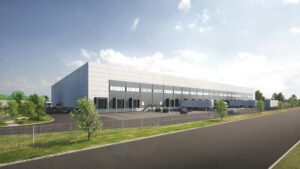The commercial real estate market is craving good news: foreign investors are pulling out, local players are trying to hold the line. But now, things seem to be turning—three industry experts weigh in on what’s next.
Andi Pleskovski, Partner and Lead Consultant at RE Kinnisvara, considers the investment by the Lithuanian logistics giant a landmark event. While the office market’s struggles have been thoroughly analyzed, the logistics segment is finally bringing positive and exciting developments. Last week, one of the largest logistics real estate developers in the Baltics—SIRIN Development—celebrated the topping-out ceremony for SIRIN PARK TÄNASSILMA, a logistics park under construction in Saku municipality. The €11.5 million warehouse has now reached its full height. According to the Lithuanian company, the project is part of a €102 million investment plan across the three Baltic countries in 2024—an investment that has certainly caught attention.
Yesterday afternoon, Ardi Roosimaa, Board Member at Restate, stated:
“After practically 12 months of market stagnation, we’re now seeing a clear uptick in activity.”
While his comment partly relates to his own company’s new development projects, it also signals something broader:
“In just the last 10 days, our sales team has closed over 5,500 m² in lease agreements. The last time we saw this kind of sprint was right after the COVID recovery,” Roosimaa said, adding: “This is a clear signal that confidence in the market and business outlook is returning. The drop in interest rates is also helping.”
This sentiment aligns closely with SIRIN Development’s financial push into Estonia.
Holger Tilk, Head of Investments at Kapitel AS; Andi Pleskovski, Partner and Lead Consultant at RE Kinnisvara; and Fred Linnukütt, Head of Industrial and Logistics at Uus Maa Kinnisvarabüroo, share their insights on the event and its wider implications.
1. How significant is this event in the context of Estonian and Baltic commercial real estate?
Tilk:
At a time when foreign real estate investors are mostly exiting the Estonian market, the arrival of a new foreign developer is both welcome and motivational for all market participants. We wish our Lithuanian colleagues success in the Estonian market. At Kapitel, following the construction of Solina’s new production facility in Gate Tallinn on Pärnu Road, we still have one last fully planned and infrastructure-ready plot for industrial/logistics development in the area. The addition of another modern industrial building nearby only enhances the region’s strong logistics reputation.
Pleskovski:
This is a highly significant event for Estonia’s commercial real estate market, for several reasons. First, this is the largest logistics building to hit the market this year, and it’s being offered for lease rather than being built for a specific end-user. Second, construction started without any pre-leases in place—a bold move for a project of this scale, as most developers wait for 20–40% pre-leasing before breaking ground. Third, after a long break, we finally see a new high-ceiling, dock-equipped logistics facility designed for larger logistics tenants entering the Harjumaa market.
In recent years, most development has focused on stock-office buildings for small and medium-sized companies, but large “big-box” warehouses haven’t been brought to market for some time. Given that SIRIN has launched similar developments in the other Baltic states, we may see cross-border tenants relocating from their facilities in Latvia or Lithuania.
Linnukütt:
It’s a bold move in the logistics sector, especially considering the current economic climate and the speculative nature of the construction. The space is available from as little as 550 m², and the flexibility in sizing is a clear advantage. The offered rent level is in line with standard new logistics properties. The location supports nearby factories and logistics centers, offering opportunities to store seasonal goods nearby.
Experience shows that leasing a building of this scale typically takes 3–4 years. Given current conditions in Estonia, it’s difficult to predict. While it’s a big step for SIRIN—their first project in Estonia—I don’t see it as a game-changer for the market overall. I remain cautiously neutral.
2. What new developments could this trigger in the Estonian and Baltic CRE markets? What trends could follow?
Tilk:
The primary winners here are potential tenants, as the market gains more variety in terms of location and quality. However, industrial tenants are still cautious about relocating or expanding, and some large companies are building their own facilities. As a result, a rise in speculative developments could temporarily increase vacancy rates in Tallinn. Still, I don’t foresee major structural changes to the market just because of one new developer’s entry.
Pleskovski:
The real milestone is that a strong, pan-Baltic developer has entered the local market after years of evaluating expansion opportunities. They now have multiple sites in Harjumaa ready for future development.
For years, logistics companies have struggled to find suitable space, as the sector has been underserved. SIRIN is now filling that gap and offering even larger tenants the chance to secure space with less than a year’s lead time.
Their bold market entry also confirms that it’s becoming increasingly difficult to sell commercial space off-plan. The most successful developers in recent years have been those willing to build with little or no pre-leasing. With well-thought-out concepts and strong locations, these buildings do tend to fill up.
Linnukütt:
This expands the range of options for local companies, but I don’t see it triggering new trends. Similar buildings are already being developed along the Tartu highway, some with even larger scale and comparable concepts.
We may, however, see a shift in pricing over the next year or two due to rising competition. This kind of construction sends a clear message to foreign investors: the Baltics and Estonia remain safe places to invest. Organizations that support foreign investment and business development in Estonia should capitalize on this opportunity.
Äripäev / Siim Sultson




